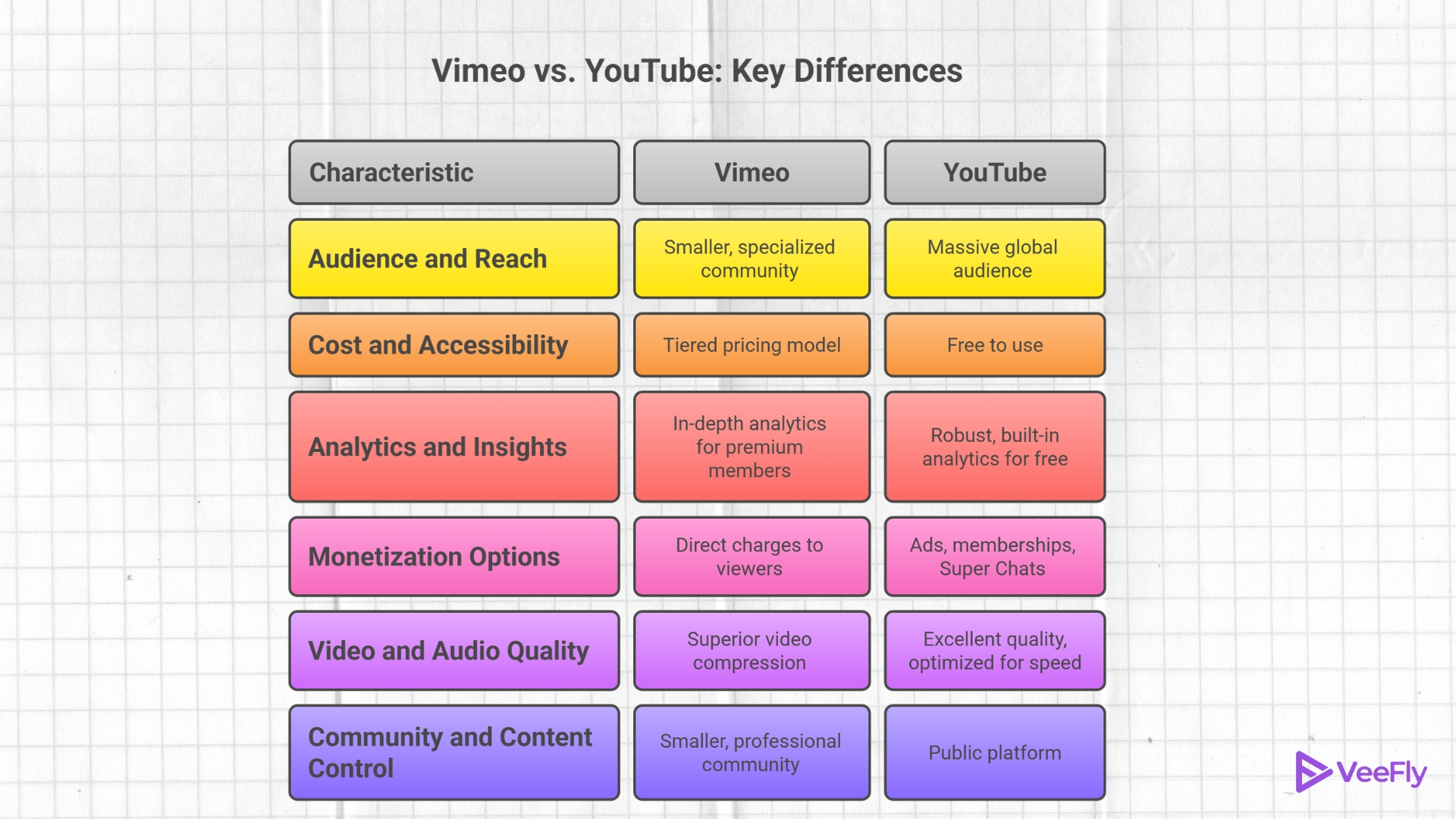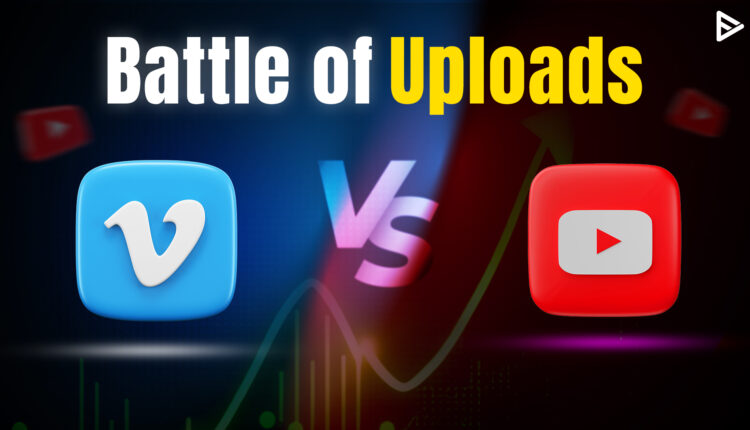In the last few decades, people have become increasingly addicted to consuming content online. This era is rife with booming opportunities for content creators who are keen on making a decent revenue! However, as a creator, you should know which platform is worth your time and money. Hence, we have curated a detailed blog on Vimeo vs YouTube to help you determine the best platform to invest in!
Main Difference Between Vimeo and YouTube for Creators
The difference between Vimeo and YouTube is simple. Popular video sharing platforms like Vimeo and YouTube serve creators in different way. While YouTube dominates the global reach, Vimeo is ideal for small creators who focus on smaller and base. Since YouTube dominates 1.9 billion worldwide, creators looking to gain a massive audience can revert to YouTube
Further, YouTube is free to use whereas Vimeo’s base price starts from $65. With Vimeo you can be sure to get unlimited live for a month. YouTube is built for robust analytics , Vimeo offers the similar data but it’s more in-depth.

Which Has Better Livestreaming: YouTube or Vimeo?
While Vimeo and YouTube have become highly reputed video-sharing platforms, they still have significant differences that shape the viewing & live-streaming experiences.
Let’s review both platforms to understand what will best fit your needs!
A brief comparison of Vimeo Vs. YouTube Livestreaming:
- YouTube has more reach than Vimeo.
- YouTube is free, while Vimeo charges!
- YouTube analytics is more insightful than Vimeo.
- Vimeo provides high-quality videos with less data.
- Vimeo has harsher content upload criteria than YouTube!
- YouTube has harsher monetization criteria than Vimeo to protect associated parties.
- YouTube provides humongous reach; hence charges slightly less for every 1000 views.
- YouTube has fewer associated costs.
1. Global Exposure
YouTube has something for all niches, whether health, lifestyle, entertainment, or work. On the other hand, Vimeo deals with highly specialized content, exploring subjects strictly related to productivity.
YouTube:
YouTube is accessible to everyone worldwide, offering content creators global exposure with its vast base of 1.9 billion active users. Below is the graph detailing the country-wise distribution of YouTube views.
Vimeo:
Conversely, Vimeo has a very specialized community, with only 90 million active users. It is also not available in all regions of the world.
YouTube is akin to a vast sea of diverse videos and content creators, whereas Vimeo creators cater to extremely specific niches.
2. Analytics
Both platforms offer basic data for creators to work with, but if you are wondering is Vimeo better than YouTube, then YouTube offers a little more with zero associated costs. Let’s find out!
Both Vimeo and YouTube provide the following statistics:
- Views, Comments, Likes, And Shares
- Total plays
- Geographical data
In addition to the above insights, YouTube equips creators with the following data at $0!
- Sources of organic traffic.
- Demographic details of viewers, such as Age and Gender.
- What devices are your viewers using?
- Viewer retention rate.
- Adding annotations or clickable spots that allow your viewers to interact.
Aside from basic insights, Vimeo will provide exclusive members with the following data!
- Visual Data that charts what percentage of viewers watch your videos for what duration and up to which segment.
- Sources & devices of organic traffic.
- You can collect email IDs of users who attended your virtual events.
3. Overall Cost
What are the costs involved in utilizing both platforms? And what benefits do creators earn from each? Let’s dig deeper!
- YouTube: YouTube provides various analytical insights and multiple live-streaming features for free, which should especially matter for budding creators who can’t invest much in the formative stages of their content development journey.
- Vimeo: Vimeo currently deploys a tiered pricing model. The free plan provides extremely limited access, while the $65/month plan allows unlimited live streaming. Vimeo pricing plans 2025 starts with $12-$20, with the advanced plan reaching up to $65.
4. Viewer Access
Vimeo vs YouTube can be based on the subscribers. What factors affect the reach of both platforms? Read ahead to find out!
YouTube has specific features that increase viewer access. Let’s study them!
- Mobile Compatibility: While videos uploaded to Vimeo and YouTube are automatically mobile-friendly, YouTube offers creators more opportunities to increase reach and discoverability.
- Reach: YouTube’s immense popularity gives creators a massive opportunity to build a dedicated fanbase. Even business channels leverage YouTube’s reach to share launches, testimonials, demonstrations, and tutorial content.
- Seat/Attendees: Thousands of viewers can attend livestream video.
Vimeo presents with restrictions for the viewers!
- Content Classification: Vimeo meticulously categorizes its content into genres, ads, animations, documentaries, and music. Thus fostering a space for creators to carve their niche in specific genres.
- Reach: Conversely, Vimeo presents a more curated community of members, making it much more professional and restricted. It is also not as global as YouTube, nor does it have as many active users.
- Seat/Attendees: Only limited users can attend livestream videos depending on the plan availed by creators.
5. Livestreaming Experience
Both video giants immerse users in their videos, but which platform allows creators to live stream more efficiently? Let’s find out!
YouTube provides creators with many features, considering zero service charges!
- Prerequisite: To live stream on YouTube, you’ll need a verified account and 1,000 subscribers – But at no pay and with unlimited seats!
- Managing virtual events: Creators can schedule virtual events, send invites, and back up their live streams with a Google-verified encoder.
- Chat Moderation: YouTube’s live-streaming doesn’t allow branding – But chat moderation tools are free of cost!
Vimeo offers many features for creators to experiment with, but they come at a cost!
- Prerequisite: You need to pay for a plan starting at $65, and there is a seat limit on viewers who can attend your livestreams.
- Features: Vimeo’s live stream enables creators to use chat, polls, and Q&A.
- Branding: Vimeo studio allows creators to switch between feeds, streams, logos, custom graphics, colors, and existing video clips to help them give their live streams or events a touch of their company brand.
6. Monetization
Every creator dreams of monetizing their channel, so it’s important to know each platform’s payment structure and earning potential. Vimeo vs YouTube affects revenue choice too.
YouTube Earning Potential:
YouTube’s monetization requirements are more stringent than Vimeo’s, as YouTube prioritizes the safety of all parties involved— Such as advertisers so that they don’t get associated with controversial content and creators so that no one steals their work.
- Revenue Potential: Ads, Channel membership, and Super Chat.
- Payment Structure: $0.3 to $5 per 1000 views (but has a massive reach and fewer associated costs).
- Revenue Sharing: YouTube takes 45% of the revenue earned through videos
Vimeo Earning Potential:
Vimeo is an ad-free platform that earns from paid plans instead. Therefore, it doesn’t prioritize protection as much as YouTube does, Resulting in fewer policies for creators to abide by.
- Revenue Potential: Subscription plans, Tip jars, and Downloading paid videos.
- Payment Structure: $0.10 per view for the first 1000 views and $0.15 for each view after that (but has a limited reach and more associated costs).
- Revenue Sharing: Vimeo charges $1 per subscriber + 24% Vat + 10% revenue sharing + Package Price
Even though Vimeo is charging slightly higher for every 1000 views, it can still not compare against the massive exposure, content flexibility, and cost efficiency that YouTube offers.
7. Audio Video Quality
Audio-video quality concerns the user experience. For content creators, this is of utmost importance. Let’s compare both internet giants!
YouTube:
The criteria for uploading videos on YouTube are more flexible, and most features are freely accessible – Hence, there’s a slight difference in audio-video quality.
- Video Length: Verified accounts can stream up to 12 hrs (no paid plan).
- Video Quality: Consumes slightly more data than Vimeo to run a video of 1080 HD.
- Audio Quality: Supports high-quality audio files like FLAC and Apple Lossless.
Vimeo:
Vimeo has set a higher benchmark for audio-video quality, but it charges viewers and creators a lot for its services as a result. It has even imposed harsher guidelines for uploading content.
- Video Length: Unlimited (but paid plan with few seats).
- Video Quality: Consumes slightly less data than YouTube to run a video of 1080 HD.
- Audio Quality: Supports high-quality audio files like FLAC and Apple Lossless.
Conclusion
Both internet giants are great for live streaming and render a good viewing experience. But which live-streaming platform is best – Vimeo Vs. YouTube – would depend on your individual goals as a creator. Filmmakers may benefit from Vimeo, but YouTube is better if you intend to become an influencer with a huge following.
Frequently Asked Questions
Q1. What is Vimeo best for?
Vimeo is best for creators who love video hosting or live streaming. It offers high-quality, making it an ideal choice for professionals.
Q2. What are the disadvantages of Vimeo?
The disadvantages of Vimeo include limited seating for viewers, harsher guidelines for uploading content, and higher revenue-sharing costs.
Q3. How much does it cost to livestream on Vimeo?
Since Vimeo doesn’t offer a free livestreaming plan, you can upgrade to an advanced plan for $65.
Q4. How much does Vimeo pay per 1,000 views?
Vimeo pays $0.10 per 1,000 views and an additional $0.15 for each view thereafter.
Summary
- YouTube offers significantly more global exposure with 1.9 billion active users compared to Vimeo's 90 million, making it better for diverse content and audience reach.
- YouTube provides more comprehensive analytics at no cost, including demographic details and viewer retention rates, while Vimeo offers limited insights for free and more detailed data for paid members.
- YouTube is free to use with various features, whereas Vimeo has a tiered pricing model that starts at $65 per month for unlimited live streaming.


